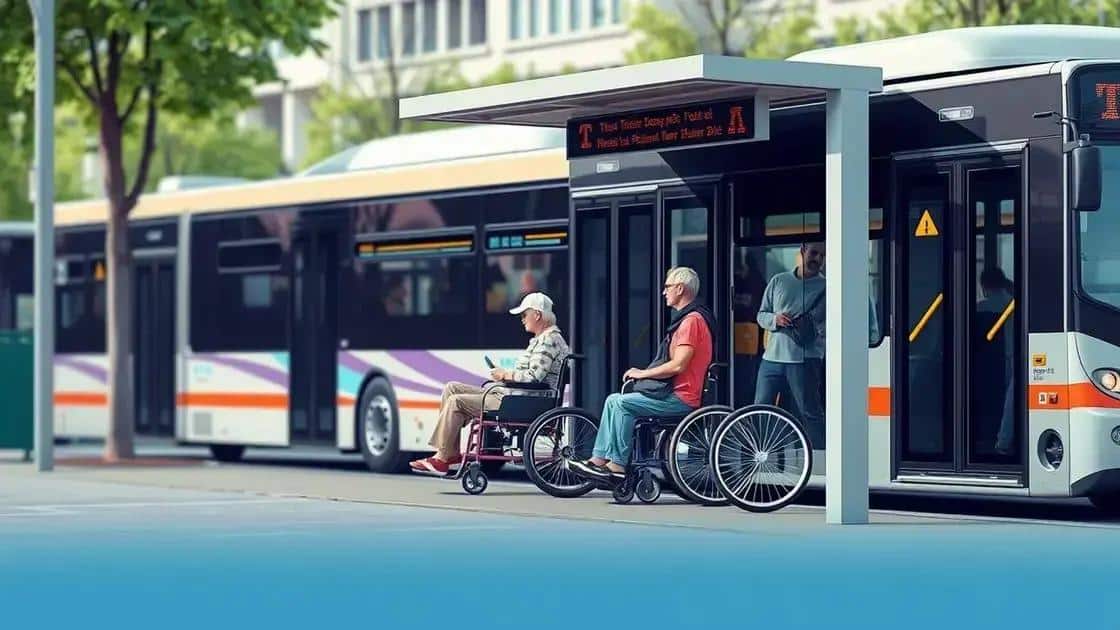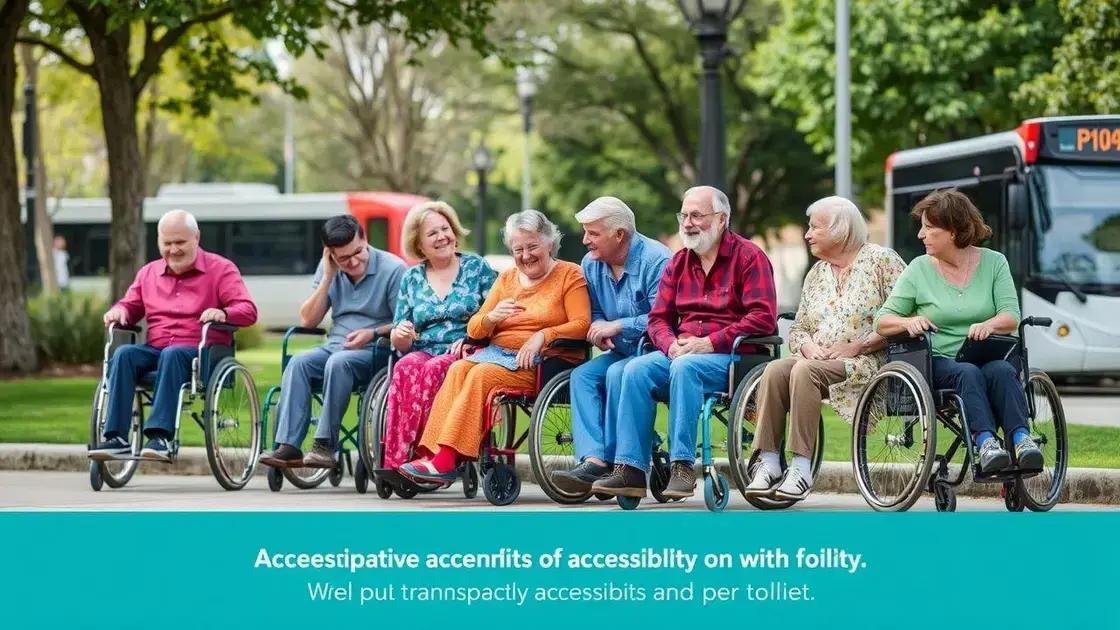Public transit subsidies for disabled residents: what you need to know

Public transit subsidies for disabled residents provide essential financial support for transportation costs, enhancing mobility and access to community resources, ultimately improving their quality of life.
Public transit subsidies for disabled residents play a crucial role in enhancing mobility and accessibility. Have you ever considered how these subsidies can transform everyday life? Let’s dive into the details.
Understanding public transit subsidies for the disabled
Understanding the public transit subsidies for the disabled is essential for improving the travel experience of many individuals. These programs aim to make transportation more accessible, allowing residents with disabilities to navigate their communities with ease.
What are public transit subsidies?
Public transit subsidies are financial aids provided by government agencies to assist individuals in covering the costs of transportation. These subsidies can significantly reduce the burden of travel expenses, especially for those with limited income.
- Direct financial assistance for travel costs.
- Discounted or free transit passes.
- Support for specialized transportation services.
- Funding for accessible vehicles.
Disabled residents often face challenges such as high transportation costs or a lack of accessible options. By understanding how these subsidies work, individuals can take advantage of the resources available to them. Many municipalities implement different subsidy programs tailored to the needs of their residents.
Who qualifies for these subsidies?
Eligibility for public transit subsidies typically includes residents with various disabilities, including physical, cognitive, or sensory impairments. Each region may have its specific criteria, often requiring documentation of the disability.
Applying for these subsidies is generally straightforward. Most programs offer online applications or in-person assistance to help individuals understand the requirements. It is vital to gather necessary documents, such as medical records or proof of income, to facilitate the process. These requirements are put in place to ensure that assistance reaches those who need it most.
By leveraging the public transit subsidies available, disabled residents can gain greater independence and access opportunities that might otherwise be limited. Understanding the specific provisions and how to apply can help facilitate a more seamless journey in everyday life.
Benefits of subsidies for disabled residents

The benefits of subsidies for disabled residents extend far beyond simple financial assistance. These programs can empower individuals, providing them with greater independence in their daily lives.
Improved Mobility
One of the critical advantages of public transit subsidies is enhanced mobility. By reducing the cost of transportation, these subsidies allow disabled residents to travel more frequently. They can attend essential appointments, socialize with friends, or explore community resources without the worry of high travel expenses.
- Access to job opportunities.
- Participation in recreational activities.
- Enhanced social interactions.
- Easier access to healthcare services.
Additionally, subsidies can help break down barriers. Many individuals with disabilities feel limited in their ability to navigate cities and towns. With affordable transit options, they can become more active participants in their communities, fostering a stronger sense of belonging.
Financial Relief
Another important benefit is the financial relief that these subsidies provide. For many families, the costs associated with transportation can be overwhelming. Public transit subsidies make it easier to manage budgets by decreasing monthly expenses related to travel.
This financial support allows individuals to allocate funds to other essential areas, such as healthcare or housing. It’s not just about saving money; it’s about opening doors to opportunities that enrich life experiences.
Furthermore, subsidies can lead to better overall health outcomes. With easier access to health services, residents can attend medical appointments regularly. This proactive approach to healthcare can prevent conditions from worsening, contributing to a better quality of life.
How to apply for transit subsidies
Knowing how to apply for transit subsidies can make a significant difference for many individuals with disabilities. The application process is designed to be straightforward, ensuring that eligible residents can receive the benefits they need.
Gather Necessary Documentation
Before starting the application, it’s essential to gather all required documents. Most programs will ask for proof of disability. This can include medical records or certification from a healthcare provider.
- Identification documents, such as a driver’s license or ID card.
- Proof of residency within the applying jurisdiction.
- Income verification for eligibility assessment.
- Medical documentation confirming your disability.
Having these documents ready will streamline the process and help prevent delays in approval.
Determine Eligibility Criteria
Each transit subsidy program may have different eligibility criteria, so it’s important to check the specific requirements of the program you’re applying for. Most programs aim to assist individuals with various disabilities who face difficulties accessing public transportation.
By understanding these criteria, applicants can see if they qualify. It is also helpful to look at any specific deadlines for applications, as some programs may have limited funding or seasonal availability.
The next step involves completing the application form. This can often be done online, but some might require paper forms. Be sure to fill in all sections accurately, as incomplete applications may lead to delays or denials. After submitting the application, monitor its status and be ready to provide any additional information if requested.
Overall, knowing how to apply for transit subsidies allows disabled residents to navigate their lives with greater ease and independence.
Real-life examples and success stories

Real-life examples and success stories of individuals benefiting from transit subsidies demonstrate the positive impact these programs can have. These stories not only inspire others but also highlight the vital connections made through accessible public transportation.
Empowering Stories
Many disabled residents have shared their experiences of how transit subsidies transformed their daily lives. For instance, Anna, a wheelchair user, found it challenging to attend job interviews due to transportation costs. After applying for transit subsidies, she gained affordable access to buses and was eventually hired. This opportunity has changed her life dramatically.
- Another story is of Mark, a visually impaired individual, who could not easily travel to his doctor appointments. The subsidies allowed him to access specialized transportation services, ensuring he received crucial medical care without financial strain.
- Similarly, Jessica, a single mother with a disability, shared that getting subsidized transit passes helped her take her children to school and participate in community events. This involvement greatly enriched her family’s quality of life.
- Additionally, Kevin, who uses a mobility scooter, reported that the access to subsidized public transit enabled him to join a local support group, fostering vital social connections.
These stories illustrate how transit subsidies not only offer financial relief but also greatly enhance quality of life and mobility. As more individuals share their successes, it becomes evident that public transit subsidies play a crucial role in building inclusive communities.
Creating a Stronger Community
When individuals like Anna, Mark, and Jessica share their lively experiences, they encourage others to consider applying for similar subsidies. Their stories highlight the importance of accessibility in public transportation, emphasizing how it can pave the way to more opportunities and stronger communal ties.
Support from transit subsidy programs helps in establishing a society where individuals with disabilities can thrive. These successes remind us of the importance of making transportation accessible for all.
FAQ – Frequently Asked Questions about Public Transit Subsidies for Disabled Residents
What are public transit subsidies?
Public transit subsidies are financial aids provided by government programs to help disabled individuals cover transportation costs.
Who is eligible for these subsidies?
Eligibility typically includes residents with disabilities. Each program may have specific requirements that need to be met.
How can I apply for transit subsidies?
You can apply by gathering necessary documentation, filling out an application form online or in person, and submitting it to the appropriate agency.
What impact do these subsidies have on daily life?
These subsidies improve mobility, reduce transportation costs, and allow disabled residents to engage more fully in their communities.





